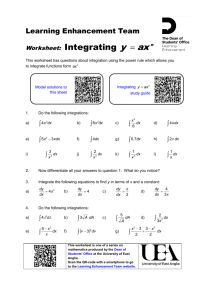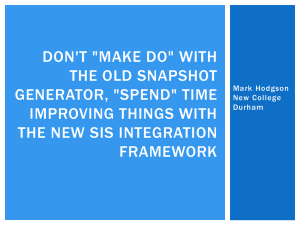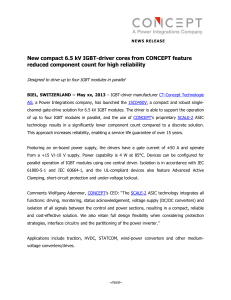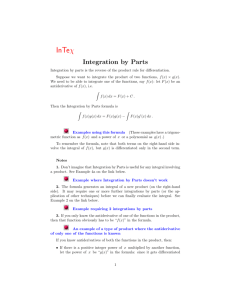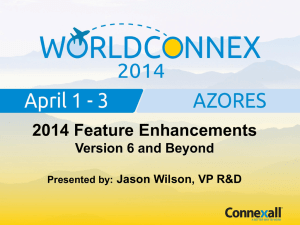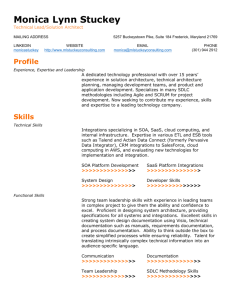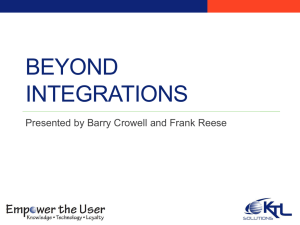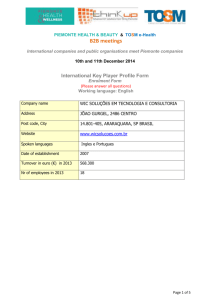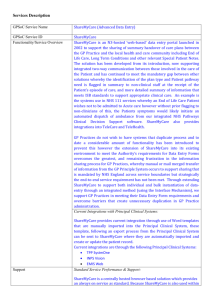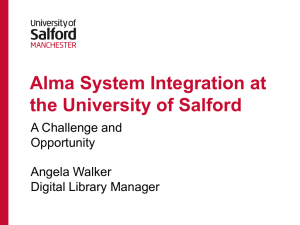Advantage Integration Strategy
advertisement
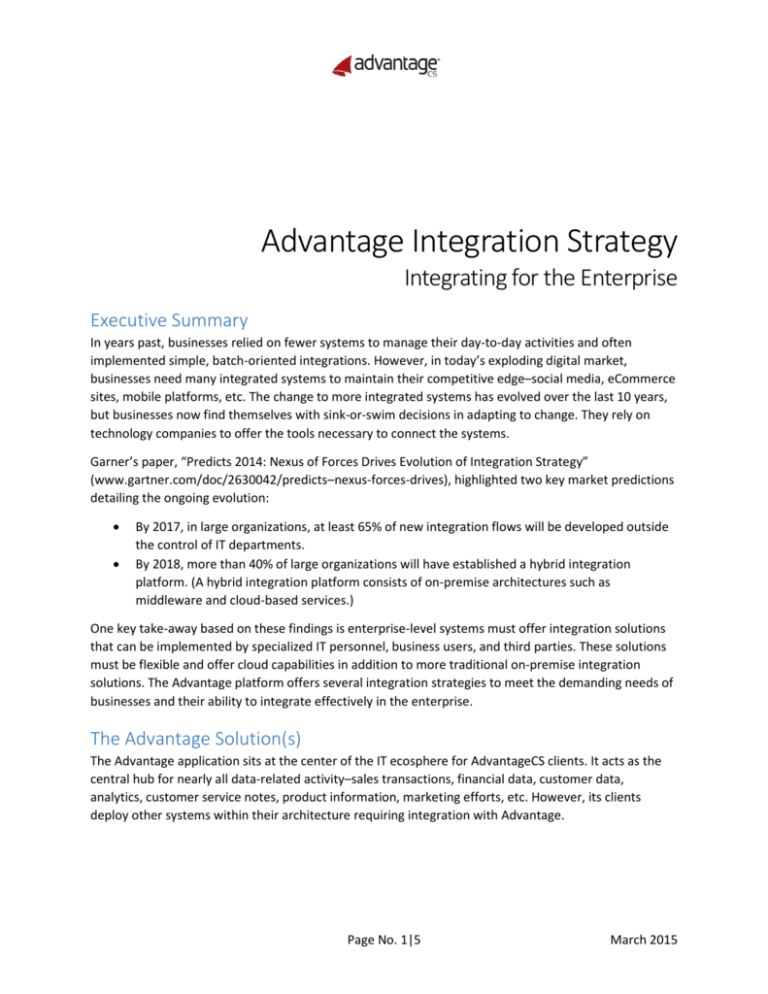
Advantage Integration Strategy Integrating for the Enterprise Executive Summary In years past, businesses relied on fewer systems to manage their day-to-day activities and often implemented simple, batch-oriented integrations. However, in today’s exploding digital market, businesses need many integrated systems to maintain their competitive edge–social media, eCommerce sites, mobile platforms, etc. The change to more integrated systems has evolved over the last 10 years, but businesses now find themselves with sink-or-swim decisions in adapting to change. They rely on technology companies to offer the tools necessary to connect the systems. Garner’s paper, “Predicts 2014: Nexus of Forces Drives Evolution of Integration Strategy” (www.gartner.com/doc/2630042/predicts–nexus-forces-drives), highlighted two key market predictions detailing the ongoing evolution: By 2017, in large organizations, at least 65% of new integration flows will be developed outside the control of IT departments. By 2018, more than 40% of large organizations will have established a hybrid integration platform. (A hybrid integration platform consists of on-premise architectures such as middleware and cloud-based services.) One key take-away based on these findings is enterprise-level systems must offer integration solutions that can be implemented by specialized IT personnel, business users, and third parties. These solutions must be flexible and offer cloud capabilities in addition to more traditional on-premise integration solutions. The Advantage platform offers several integration strategies to meet the demanding needs of businesses and their ability to integrate effectively in the enterprise. The Advantage Solution(s) The Advantage application sits at the center of the IT ecosphere for AdvantageCS clients. It acts as the central hub for nearly all data-related activity–sales transactions, financial data, customer data, analytics, customer service notes, product information, marketing efforts, etc. However, its clients deploy other systems within their architecture requiring integration with Advantage. Page No. 1|5 March 2015 The nature of these integrations can vary widely depending on the specifics of the other systems. For example, an eCommerce site will require real-time integration, but a financial system may be satisfied by daily feeds of transactional data. It is important for an enterprise-level system to provide this type of flexibility in the integration strategy without the need for constant customization. Software Development Kit (SDK) Advantage offers four means for programmatic access to the application and data within its SDK: Java API, .NET API, REST API, and SOAP API. Each API provides access to a wide range of core areas including products, marketing, customers, orders, payments, and entitlements. They provide access to the Advantage data model and share business logic with the core Advantage application. This ensures the use of the API’s is consistent with the standard functions of the application. Workflow Events As the center of business transactions, there is a constant flow of data through the Advantage system– web orders, customer service inquiries, payments, general ledger entries, etc. Businesses often want to capture specific events and take an appropriate action. Advantage supports this workflow through a flexible, event-driven framework. The framework consists of subscribing to events, filtering to a subset of those events, and specifying the actions to take. Once the framework has been configured, Advantage begins capturing the events as they occur and processing them in near real-time. The events are captured at the object level and are incorporated directly into the application. Example events include customer created, order completed, payment applied, and access granted. The actions Page No. 2|5 March 2015 offer a variety of possibilities as well–send an email or execute a business-specific web service with a specified JSON/XML payload. This powerful framework provides important benefits such as increased customer engagement, low maintenance data sharing, and near real-time data integration with other systems. Standard Third-party Integrations Advantage supports out-of-the-box integrations with many third parties. These integrations provide point-to-point connections with some of the leading providers of services. Examples of integrations are: Address standardization – Satori Credit card processing – CyberSource Taxation – ONESOURCE Indirect Tax Direct debit validation – Bank Finder These integrations require Advantage system configuration, but do not require developer support in most instances. These types of integrations can be attractive to businesses wanting out-of-the-box integrated solutions. Extensibility Framework The integrations described in the previous section are implemented using Advantage’s Extensibility Framework. This framework provides a plug-in architecture for third-party integrations by implementing the provided extensibility points. An extensibility service implementation (e.g., plug-in) can be implemented as a .NET DLL or as a web service where the base Advantage plug-ins are created using DLL’s. These plug-ins can route the calls through an enterprise service bus or other middleware application. This framework provides clients the flexibility when integrating third-party applications. Page No. 3|5 March 2015 Scribe Connector Advantage has an established partnership with Scribe (www.scribesoft.com) to provide a seamless integration solution to other market leaders such as Salesforce and Microsoft Dynamics. Custom integrations can be expensive for businesses from resource, cost, and timeline perspectives. Scribe offers an alternative solution by using a mapping methodology allowing Advantage to connect with other systems. For example, clients can connect Advantage with Salesforce and share customers and sales transactions in real-time. Scribe offers a low-cost technical option for integrating Advantage to other enterprise-level applications through its easy-to-use mapping interface. Data Warehousing There are some integrations that require a regularly occurring feed of transactional data, such as general ledger packages as opposed to real-time integrations. Advantage offers a data warehousing feature whereby records are written to extract tables as transactions are processed by the system. This allows other systems to consume the deltas of data at any interval–once an hour, once a day, etc. This feature removes the reliance on understanding the Advantage data model and allows the business user to consume the types of data relevant to specific integrations. These data warehouse feeds are completely customizable and can be delivered in various formats (e.g., SQL vs. XML). Business Intelligence AdvantageCS offers a Business Intelligence Module that is guided by two key principles: providing accessible data and ensuring an extensible model. The BI solution uses technologies that seamlessly fit into the existing Advantage ecosphere and leverages Microsoft products that businesses are likely familiar with. Within the context of integrations, the BI solution offers a data warehouse constructed of denormalized transactional data. This data warehouse can be an important source of data for certain types of integrations such as reporting systems. Page No. 4|5 March 2015 The Advantage transactional system can be a complex system to access directly from the data layer. Additionally, businesses often want to limit the types of integrations directly accessing the transactional system to reduce efficiency bottlenecks. This differs from the aforementioned data warehousing feature in that the BI data warehouse represents a denormalized, full set of data–not just deltas of transactions. The BI data warehouse offers a powerful view of the rich transactional data that can be easily consumed by other systems. Summary To stay competitive, businesses must have reliable integrations between the various systems in their respective IT ecospheres. The systems must be flexible enough to support the various models of integrations–simply providing one means of integration is not sufficient. For AdvantageCS clients, the Advantage platform acts as the engine of their business and provides many integration options ensuring a well-structured integrated environment. Page No. 5|5 March 2015
